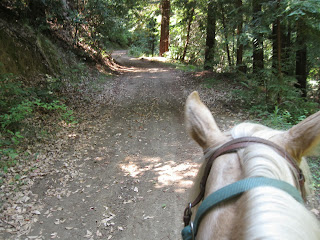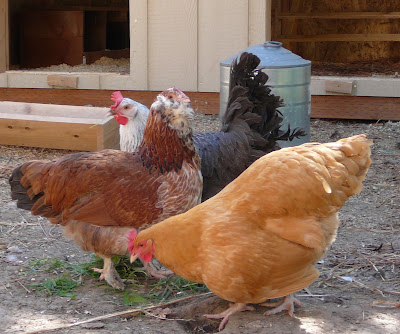by Laura Crum
If
you’ve owned horses for any length of time, you have dealt with lameness. It’s
just a fact of life with horses. They go lame from time to time. If you’re
lucky, it’s not permanent. If you’ve never had a lame horse, you just haven’t
owned enough horses, or owned any horse a long time.
So
I’ve been really lucky when it comes to lameness. I can pat myself on the back
and say it’s because I have great horse keeping/riding practices and I know how
to pick the sort of horse that stays sound, and maybe this has something to do
with it. But really, maybe I’ve just been lucky.
As
of last year at this time, I had five completely sound horses on my place,
including my retired 32 year old horse, my retired 23 year old horse, my riding
horse, my son’s riding horse and my friend’s horse that I board here. Today?
Well, the boarder is still sound.
I
know, it sounds bad. But it is part of life with horses.
I
retired Gunner, my now 33 year old horse, when he was 18 because he had enough
arthritic changes that I felt he would be more comfortable if I didn’t work
him. I retired Plumber (now 24) at 19 for the same reason. Both horses became
much more free moving after some time off, and would long trot freely and
completely sound as retired barefoot pasture pets. And this made me happy.
Last
winter Gunner got cast and was down (I think) most of the night. I found him
there at morning feeding. He was stuck in a hollow by the fence and we had a
very hard time getting him up (took a couple of hours). He was in pretty rough
shape when he finally stood up, and I thought it was the end. But my vet
convinced me that the horse could pull through, and this turned out to be true.
It took a couple of weeks, but eventually Gunner was trotting sound again.
However, he was never as free moving as he had been before being cast. Still,
he was sound, he ate well, his weight was good, he would buck and play—I
thought his quality of life was good enough. Here you see Gunner this summer.
Several
months after being cast, Gunner fell while running around screaming for his
buddy (who I had taken out of the corral). Gunner got up from that fall
limping, and since then developed some very obvious arthritic changes in his
left knee. And he was lame. When it became clear that this wasn’t going to
resolve on its own, I had the vet out.
To
cut to the chase—yep, he had bad arthritis in his knee, and we put him on
Previcox—a pain killer which works well for long term use in arthritic horses.
Gunner got better. But he never got really completely sound. And now, as it
gets colder, he’s a little more off on that left front, despite the drug.
He
still bucks and plays a little, he eats well, his weight is pretty good. But
he’s definitely lame. Here he is a week or two ago—getting fuzzy for winter.
Gunner
will be 34 next spring if he makes it that long. Right now I think his quality
of life is good enough. But if he keeps getting lamer, I will have a hard
choice to make. I have buted older horses to keep them comfortable, and I could
do this with Gunner, but I am not sure I want to push this 33 year old horse to
make it through another cold rainy muddy winter (and he hates being confined so
locking him up in a stall won’t work). The end result is the same. Eventually
the bute won’t mask the pain, as the Previcox is currently starting to fail to
do. Do I just want to prolong this so Gunner can stand in the rain? I’m not
sure.
And
then, just for icing on the cake, three weeks ago I went down to feed and 24
year old Plumber was lame in the right front. Plumber has been sound and
comfortable, so my first thought was an abscess or a bruise. It just so
happened the farrier was coming that day, so we trimmed Pulmber and used the
hoof testers and could find nothing. No bruise, no tenderness. Also no
swelling, no heat, no sign of injury anywhere on the leg or foot. But lame in
the right front. OK then.
I
did not call the vet because I have been down this road before. We had done
most of what a vet could do. The next step was X-rays. I decided to wait and
see if Plumber got worse or better. If he got worse it was probably an abscess
and would become much easier to diagnose. If he got better, well, as we expert
horsemen say, he just tweaked himself. Or, more accurately, he probably aggravated
an existing low level arthritic condition (such as ringbone, sidebone or
navicular).
Every
day I checked Plumber out. First he got better. Then he got lamer. Then better.
Then lamer. And then consistently a little better every day. Right now you can’t
tell he is off unless you jog him in a circle on hard ground. Trotting in a
straight line in his corral, he looks sound. And that’s sound enough for his
pasture pet life. We’ll see what the future brings.
Here
you see my son giving Plumber a little love.
Ok,
retired horses having soundness problems is par for the course. At least my
riding horses were sound. We’ve been riding two or three days a week all summer
and having lots of fun. I’ve particularly been enjoying riding in the redwood
forest on Sunny.
My
son and Henry have enjoyed chasing cattle.
My
son started his junior high homeschool program three weeks ago, and we have
been really busy getting up to speed with that. We took a brief break from
riding just due to how busy we’ve been. But last week things seemed to smooth
out and we decided to go for a ride. We saddled up and my son started to warm
Henry up. Henry is 25 and though he is still sound, his hocks are getting
stiff. He needs lots of walking before he is asked to do more.
I
led Sunny out on the driveway to climb on and dang, he looked lame. I jogged
him. He WAS lame. Lame in the left front. I picked his foot carefully. No
obvious problems in the foot. Also no injuries, swelling or heat in foot or
leg. I jogged him again. Still lame.
This
was a big surprise because Sunny gallops around in his corral every day at
feeding time and trots up and down the fence, and I had seen no sign of
lameness. But he was definitely lame in the left front now—too lame to ride. I
unsaddled him, let him graze a little, and turned him back out.
I
bought both Sunny and Henry roughly six years ago. They have both been
completely sound virtually the whole time I have owned them, and taken us on
hundreds and hundreds of rides. In the nearby hills, on the beach, gathering
cattle—we even hauled them to the Sierras. They have been barefoot almost the
entire time. As Henry has gotten older, we’ve quit loping a lot of circles on
him, but that has been the only real change. These two horses have been sound,
solid riding horses for six years and given us an amazing amount of use. Henry
is 25—Sunny is possibly as old as 20. So I wasn’t entirely shocked to find that
Sunny was having a soundness problem. To be frank, I knew this would happen
eventually. And eventually just happens to be now.
My
horses are all older. This is what happens when you don’t get rid of your
beloved friends once they get past their best working years. To put it simply:
you have older horses with soundness problems. I accept this. That doesn’t mean
it makes me happy. But I accept it.
I
am going to give Sunny some time off and see if his lameness will resolve
(unless he gets worse, in which case I will have the vet out ASAP). But if he
still gallops up the hill at feeding time and trots without a head bob in his
corral (as he did this morning), I think his quality of life is OK. I’m not
sure about mine. I am pretty addicted to going for a ride any time I feel like
it.
Anyway,
it’s early days to make predictions. Sunny may be sound next week. Or I may
have the vet out and we’ll put Sunny on the Previcox, if that seems like the
right choice. Or maybe it’s an abscess. If so, it will show itself and I’ll
deal with it. For the moment, I’m going to take a deep breath and be grateful
for all the happy rides I’ve had on my good little yellow mule. I’ll turn him
out to graze, and give him lots of attention and accept the fact that owning
and loving horses means dealing with lameness. It’s not all about happy rides
in the sunshine. Sunny has given me plenty of wonderful rides and taken really
good care of me—now it’s my turn to take care of him.





















